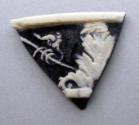Rim Fragment from a Cameo Glass Plate
Rim Fragment from a Cameo Glass Plate
Place of OriginItaly, likely Rome or Bay of Naples
Dateabout 15 BCE - 25 CE (Roman, Augustan)
DimensionsL: 1 5/8 in. (4.1 cm)
MediumCameo glass.
ClassificationGlass
Credit LineGift of Edward Drummond Libbey
Object number
1923.1601
Not on View
DescriptionOpaque white decoration on translucent blue glass. A rim fragment from a large, shallow dish, featuring a dashed white inner border and a solid outer border. The relief decoration consists of acanthus leaves and scrolling tendrils, achieved through the cameo glass technique, in which a white overlay was selectively removed to reveal the blue ground.
This fragment is thought to belong to the same vessel as Acc. Nos. 1923.1590, 1923.1606, and 1923.1607.
Label TextOpaque white decoration on translucent blue glass. A rim fragment from a large, shallow dish, featuring a dashed white inner border and a solid outer border. The relief decoration consists of acanthus leaves and scrolling tendrils, achieved through the cameo glass technique, in which a white overlay was selectively removed to reveal the blue ground. This fragment is thought to belong to the same vessel as Acc. Nos. 1923.1590, 1923.1606, and 1923.1607. Acquired by Edward Drummond Libbey in 1919 from the family of Thomas Hulse Curtis. The Curtis collection was largely acquired in the 1890s from Charles Caryl Coleman, an American artist who resided first in Rome and later on the island of Capri. This collection history strongly suggests a findspot in or around Rome or the Bay of Naples.Published ReferencesRoberts, Paul, William Gudenrath, Veronica Tatton-Brown, and David Whitehouse, Roman Cameo Glass in the British Museum, London, British Museum Press, 2010, pp. 47, 57, 58.
about 15 BCE - 25 CE (Roman, Augustan)
about 15 BCE - 25 CE (Roman, Augustan)
about 15 BCE - 25 CE (Roman, Augustan)
1st century BCE - 3rd century CE
about 15 BCE - 25 CE (Roman, Augustan)
Pierre Delabarre
Glass: before 1630; Mount: c. 1630; Case: c. 1700
1st century BCE - 3rd century CE
about 15 BCE - 25 CE (Roman, Augustan)
about 15 BCE - 25 CE (Roman, Augustan)
1st century BCE - 4th century CE
3rd to 1st century BCE
about 15 BCE - 25 CE (Roman, Augustan)

Membership
Become a TMA member today
Support TMA
Help support the TMA mission












